Groundwater Condition and Management in Kano Region, Northwestern Nigeria
Abstract
:1. Introduction
- (i)
- Identifying areas with groundwater deficiency and challenges in the region;
- (ii)
- Determining groundwater quality status in the region;
- (iii)
- Recommending what should be the focus of groundwater management in the region.
2. Materials and Methods
2.1. Geographical Background of Kano Region
2.2. Methods
3. Results
3.1. Concept of Water Resources Management
3.2. Groundwater Availability and Uses
3.3. Groundwater Depletion
3.4. Groundwater QualityStatus
3.5. Recommended Management Strategies
3.5.1. Managed Aquifer Recharge
3.5.2. Reclamation and Re-Use
3.5.3. Rainfall Harvesting
3.5.4. Management of Wet Season Groundwater Excess
3.5.5. Floodplain Management
4. Discussion
5. Conclusions
Acknowledgments
Author Contributions
Conflicts of Interest
References
- Olofin, E.A. Geographical Hydrology, Lecture Notes on GEO 3214. In Introduction to Geographical Hydrology; Department of Geography, Bayero University: Kano, Nigeria, 2011; pp. 18–27. [Google Scholar]
- The Millennium Development Goals Report. United Nations Newyork. Available online: http://www.un.org/zh/millenniumgoals/pdf/MDGReport2006.pdf (accessed on 12 December 2016).
- Kumar, M.; Kumari, K.; Ramanathan, A.L.; Saxena, R. A Comparative Evaluation of Groundwater Suitability for Irrigation and Drinking Purposes in two Intensively Cultivated Districts of Punjab, India. Environ. Geol. 2007, 53, 553–574. [Google Scholar] [CrossRef]
- Nakoma, O.; Chidya, R.C.G.; Matamula, S.; Chawinga, C.B.J. Evaluation of Borehole Water Quality in Rural-Areas of Northern Malawi: Case of Zombwe in Mzimba. Phys. Chem. Earth 2016. [Google Scholar] [CrossRef]
- Xu, Y.; Usher, B. Groundwater Pollution in Africa, 1st ed.; Tylor and Fransis Group plc: Leiden, The Netherlands, 2006. [Google Scholar]
- Ghana Statistical Service. Housing and Population Census Report; Ghana Statistical Service: Accra, Ghana, 2012.
- Elisante, E.; Muzuka, A.N.N. Assessment of Sources and Transformation of Nitrate in Groundwater on the Slopes of Mount Meru, Tanzania. Environ. Earth Sci. 2016, 75. [Google Scholar] [CrossRef]
- Akujieze, C.N.; Coker, S.J.L.; Oteze, G.E. Groundwater in Nigeria—A Millennium Experience—Distribution, Practice, Problems and Solutions. Hydrogeol. J. 2003, 11, 259–274. [Google Scholar] [CrossRef]
- Tukur, A.I.; Garba, I.; Mustapha, A.; Umar, D.A.; Sulaiman, W.A.S. An Overview of Groundwater Quality Studies in Developing Countries. In Economic Diversification through Sustainable Mineral Resources Development, Proceedings of the 52nd Annual International Conference and Exbihition of the Nigerian Mining and Geosciences Society (NMGS), Ilorin, Nigeria, 13–18 March 2016; Kwara State NMGS: Ilorin, Nigeria, 2016. [Google Scholar]
- Baba, A.; Tyfur, G. Groundwater Contamination and its Effect on Health in Turkey. Environ. Monit. Assess. 2011, 183, 77–94. [Google Scholar] [CrossRef] [PubMed]
- World Health Organization (WHO) and World Water Assessment Programme (UNESCO-WWAP). Water for People—Water for Life; The United Nations, World Water Development Report; UNESCO Publishing: Paris, France, 2004. [Google Scholar]
- Mays, L.W. Integrated Urban Water Management: Arid and Semi-Arid Regions; Tylor and Fransis Group plc: Leiden, The Netherlands; UNESCO Publishing: Paris, France, 2009; pp. 1–73. [Google Scholar]
- Federal Republic of Nigeria. Central Bank of Nigeria Population Data; Federal Republic of Nigeria: Abuja, Nigeria, 2015. [Google Scholar]
- Akinyemi, J.O.; Souley, S.O. Monitoring the Quality of Some Sources of Irrigation Water in Different Parts of Ogun State, Nigeria. IERI Procedia 2014, 9, 123–128. [Google Scholar] [CrossRef]
- Olofin, E.A. Some Aspects of the Physical Geography of Kano Region and Related Human Responses; Departmental Lecture Note Series, No. 1; Department of Geography, Bayero University: Kano, Nigeria, 1987; pp. 1–58. [Google Scholar]
- Abdulhamid, A. Drainage, Hydrology and Water Resources. In Kano: Environment, Society and Development, 1st ed.; Tanko, A.I., Momale, S.B., Eds.; Adonis and Abbey: London, UK; Abuja, Nigeria, 2014; Volume 1, pp. 21–34. ISBN 978190911291 (Paper Back), 9781909112407 (Hard Cover). [Google Scholar]
- Tahir, A.G.; Garba, M.L.; Hamidu, I. Hydrogeology and Groundwater Quality of Deep and Shallow Boreholes in Kano Metropolis, Northwestern Nigeria. J. Environ. Earth Sci. 2015, 5, 160–166. [Google Scholar]
- Abdulhamid, A.; Badamasi, M.M.; Muhammed, M.U. Dynamics of Rainfall Pattern and Groundwater Quantity in Kano Basement Complex: Evidence from Ground and Satellite Data. In Proceedings of the 1st International Conference on Drylands, Center for Dryland Agriculture, Bayero University, Kano, Nigeia, 8–12 December 2014; pp. 188–196. [Google Scholar]
- Tukur, A.I. Evaluation of Groundwater Yield and Quality for Fadama Irrigation along Hadejia River Basin, Jigawa State, Northwestern Nigeria. Unpublished Ph.D. Thesis, Department of Geography, Bayero, University, Kano, Nigeria, November 2017. [Google Scholar]
- Mohammed, S.H. GIS-Based Modified Aquifer Modeling for Pollution Vulnerability Assessment in Kano, Nigeria. Unpublished Ph.D. Thesis, University Putra Malaysia, Selangor, Malaysia, April 2015. [Google Scholar]
- Garba, A.; Ekanem, E.O.; Garba, I.H.; Mustapha, A. Multivariate Statistical Analysis of Groundwater Chemistry Data from Hadejia Local Government Area of Jigawa State, Nigeria. Glob. J. Adv. Res. 2016, 3, 713–722. [Google Scholar]
- Sobowale, A.; Adewumi, J.K.; Otun, J.A.; Adie, D.B. Water Resources Potentials of Hadejia River Sub-Catchment of Komadugu Yobe River Basin in Nigeria. Agric. Eng. Int. CIGR J. 2010, 12, 1–9. [Google Scholar]
- Adamu, G.K.; Tukur, R.; Kankara, A.I. Groundwater Quality Assessment in the Basement Complex Areas of Kano State Nigeria. Am. J. Eng. Res. 2013, 2, 171–175. [Google Scholar]
- Umar, M.H. Analysis of Groundwater Fluctuation in Hadejia. Unpublished Master’s Thesis, Department of Geography, Kano University of Science and Technology, Wudil, Nigeria, 2016. [Google Scholar]
- Tasi’u, Y.R.; Igusi, E.O.; Malam, I. Assessment of Water Supply Situation in the Rural Areasof Kano State, Northern Nigeria. Glob. Adv. Res. J. Agric. Sci. 2016, 5, 33–41. [Google Scholar]
- Rizwan, M.; Kulshreshtha, V.; Dev, P. Effects of Rainfall Factor on Hydrogeological System Recharge in Bangar Environs: A Middle Part of India. Bull. Pure Appl. Sci. 2017, 36, 27–43. [Google Scholar] [CrossRef]
- Mastrocicco, M.; Colombani, N.; Salemi, E.; Castaldelli, G. Reactive Modeling of Denitrification in Soils with Naturaland Depleted Organic Matter. Water Air Soil Pollut. 2011, 222, 205–215. [Google Scholar] [CrossRef]
- Colombani, N.; Osti, A.; Volta, G.; Mastrocicco, M. Impact of Climate Change on Salinization of Coastal Water Resources. Water Resour. Manag. 2016, 30, 2483–2496. [Google Scholar] [CrossRef]
- MacDonald, A.M.; Bonsor, H.C.; Dochartaigh, B.E.O.; Taylor, R.G. Quantitative Maps of Groundwater Resources in Africa. Environ. Res. Lett. 2012, 7. [Google Scholar] [CrossRef]
- Taylor, R.G.; Koussis, A.D.; Tindimugaya, C. Groundwater and Climate in Africa—A review. Hydrol. Sci. J. 2009, 4, 655–664. [Google Scholar] [CrossRef]
- Adewuyi, T.O.; Olofin, E.A. Spatio-Temporal Analysis of Flood Incidence in Nigeria and Its Implication for Land Degradation and Food Security. J. Agric. Sci. 2014, 6. [Google Scholar] [CrossRef]
- Bakhari, A. Hydrochemical Assessment of Groundwater Quality in the Chad Basinaround Maiduguri, Nigeria. J. Geol. Min. Res. 2014, 6. [Google Scholar] [CrossRef]
- Fagbote, E.O.; Olanipekun, E.O.; Uyi, H.S. Water Quality Index of the Groundwater of Bitumen Deposit Impacted Farm Settlements using Entropy Weighted Method. Int. J. Environ. Sci. Technol. 2013. [Google Scholar] [CrossRef]
- Sheriff, A.; Obiefuna, G. Assessment of Shallow Ground Water Quality of Pindiga Gombe Area, Yola Area, NE, Nigeria for Irrigation and Domestic Purposes. Res. J. Environ. Earth Sci. 2011, 3, 131–141. [Google Scholar]
- Obiefuna, I.G.; Orazulike, D.M. The Use of Anion Geochemistry in Mapping Groundwater Facies of Yola Area NE Nigeria. Res. J. Chem. Sci. 2011, 1, 130–141. [Google Scholar]
- Adelana, S.M.A. Nitrate Pollution of Groundwater in Nigeria. In Groundwater Pollution in Africa, 1st ed.; Xu, Y., Usher, B., Eds.; Tylor and Fransis Group plc: Leiden, The Netherlands, 2006; p. 23. [Google Scholar]
- Boukari, M.; Alassane, A.; Azonsi, F.; Dovonou, F.A.L.; Tossa, A.; Zogo, D. Groundwater Pollution from Urban Development inCotonou City, Benin. In Groundwater Pollution in Africa, 1st ed.; Xu, Y., Usher, B., Eds.; Tylor and Fransis Group plc: Leiden, The Netherlands, 2006; pp. 125–138. [Google Scholar]
- Graham, W.B.R.; Pishiria, I.W.; Ojo, I.O. Monitoring of Groundwater Quality for Small-Scale Irrigation: Case Studies in the Southwest Sokoto-Rima Basin, Nigeria. CIGR J. 2006, 8, 1–9. [Google Scholar]
- Mehra, M.; Oinam, B.; Singh, C.K. Integrated Assessment of Groundwater for Agricultural Use in Mewat District of Haryana, India Using Geographical Information System (GIS). J. Indian Soc. Remote Sens. 2016. [Google Scholar] [CrossRef]
- Gereish, M.H.; Balke, K.D.; El-rayes, A.E.; Mansour, B.M. Implications of Climate Change on the Groundwater Flow Regime and Geochemistry of the Nile Delta, Egypt. J. Coast. Conserv. 2015, 19, 589–608. [Google Scholar] [CrossRef]
- Sappa, G.; Ergul, S.; Ferranti, F.; Sweya, L.N. Effects of Seasonal Change andSeawater Intrusion on Water Quality for Drinking and Irrigation Purposes in Coastal Aquifers of Dar es Salaam, Tanzania. J. Afr. Earth Sci. 2015. [Google Scholar] [CrossRef]
- Sharma, S.; Chippa, R.C. Interpretation of Groundwater Quality Parameter forSelected Area of Jaipur Using Regression and Correlation Analysis. J. Sci. Ind. Res. 2013, 72, 781–783. [Google Scholar]
- Barbiero, L.; Neto, J.P.D.Q.; Ciornei, G.; Sakamato, A.Y.; Capellari, B.; Fernande, E.; Valles, V. Geochemistry of Water and Groundwater in the Nhecolandia, Pantanal of mato grosso, Brazil: Variability and Associated Processes. Wetlands 2002, 22, 528–540. [Google Scholar] [CrossRef]
- American Public Health Association (APHA). Standard Methods for the Examination of Water and Wastewater, 1st ed.; American Public Health Association, American Water Workers Association, Water Environment Federation: Washigton, DC, USA, 2005; Volume 2. [Google Scholar]
- Olofin, E.A. Water Resources Planning and Management: Lecture Notes on WMA 501. In Water Resources Planning and Management; Department of Water Resources Management and Agro-Meteorology, Federal University of Oye-Ekiti: Ikole, Nigeria, 2016; pp. 1–8. [Google Scholar]
- Ayoade, J.O. Tropical Hydrology and Water Resources; Macmillan Publishers Ltd.: London, UK, 1988; p. 189. [Google Scholar]
- Tanko, A.I. Water Resource Development and Management. In Kano: Environment, Society and Development, 1st ed.; Tanko, A.I., Momale, S.B., Eds.; Adonis and Abbey: London, UK; Abuja, Nigeria, 2014; Volume 1, p. 228. ISBN 978190911291 (Paper Back), 9781909112407 (Hard Cover). [Google Scholar]
- Zuhair, A.; Nouh, M.; El Sayed, M. Flood Harvesting in Selected Arab States, Final Report No. M31/99, Institute of Water Resources. In Integrated Urban Water Management: Arid and Semi-Arid Regions; Mays, L.W., Ed.; UNESCO Publishing: Paris, France; Leiden, The Netherlands, 1999; p. 46. [Google Scholar]
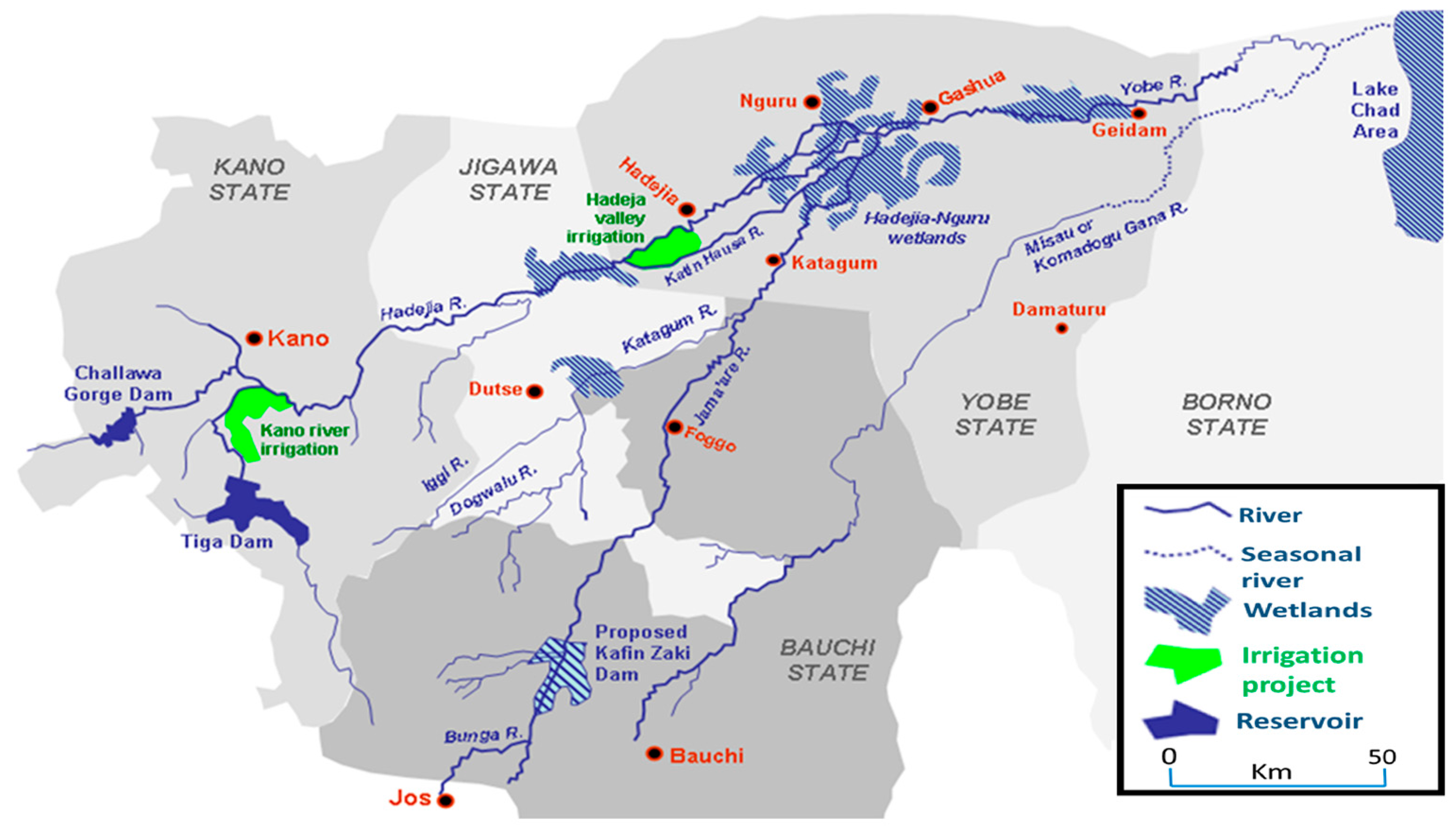
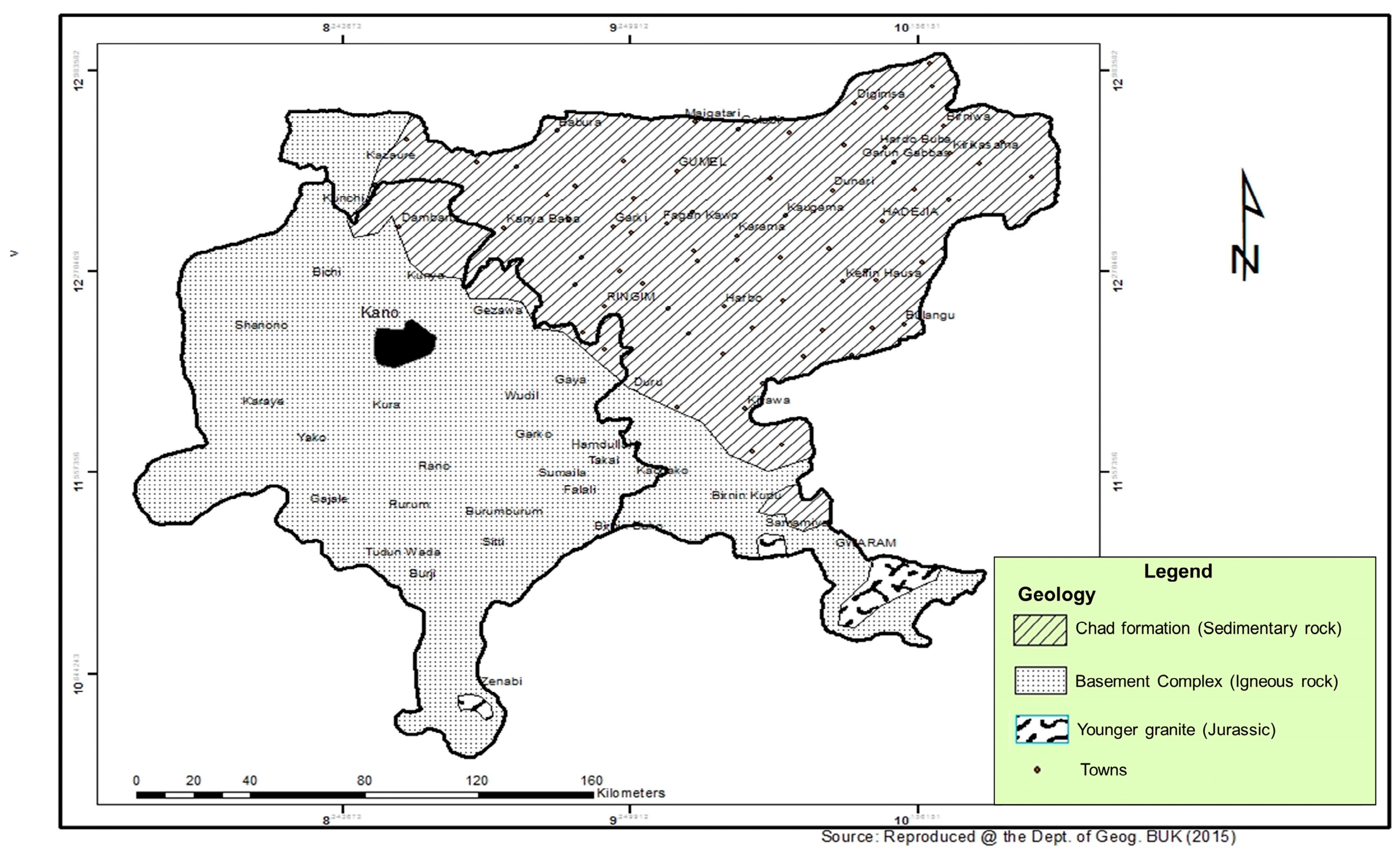
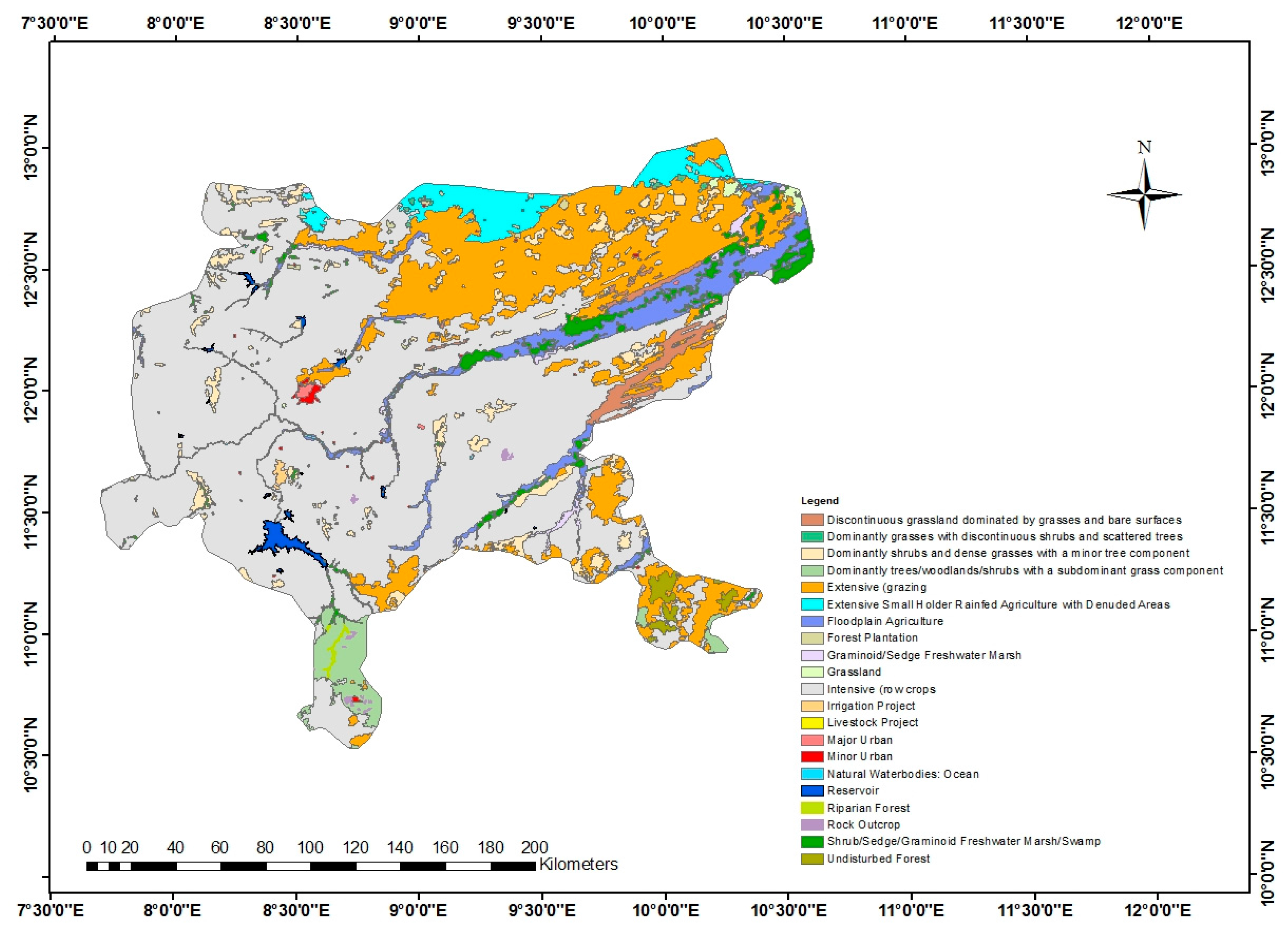
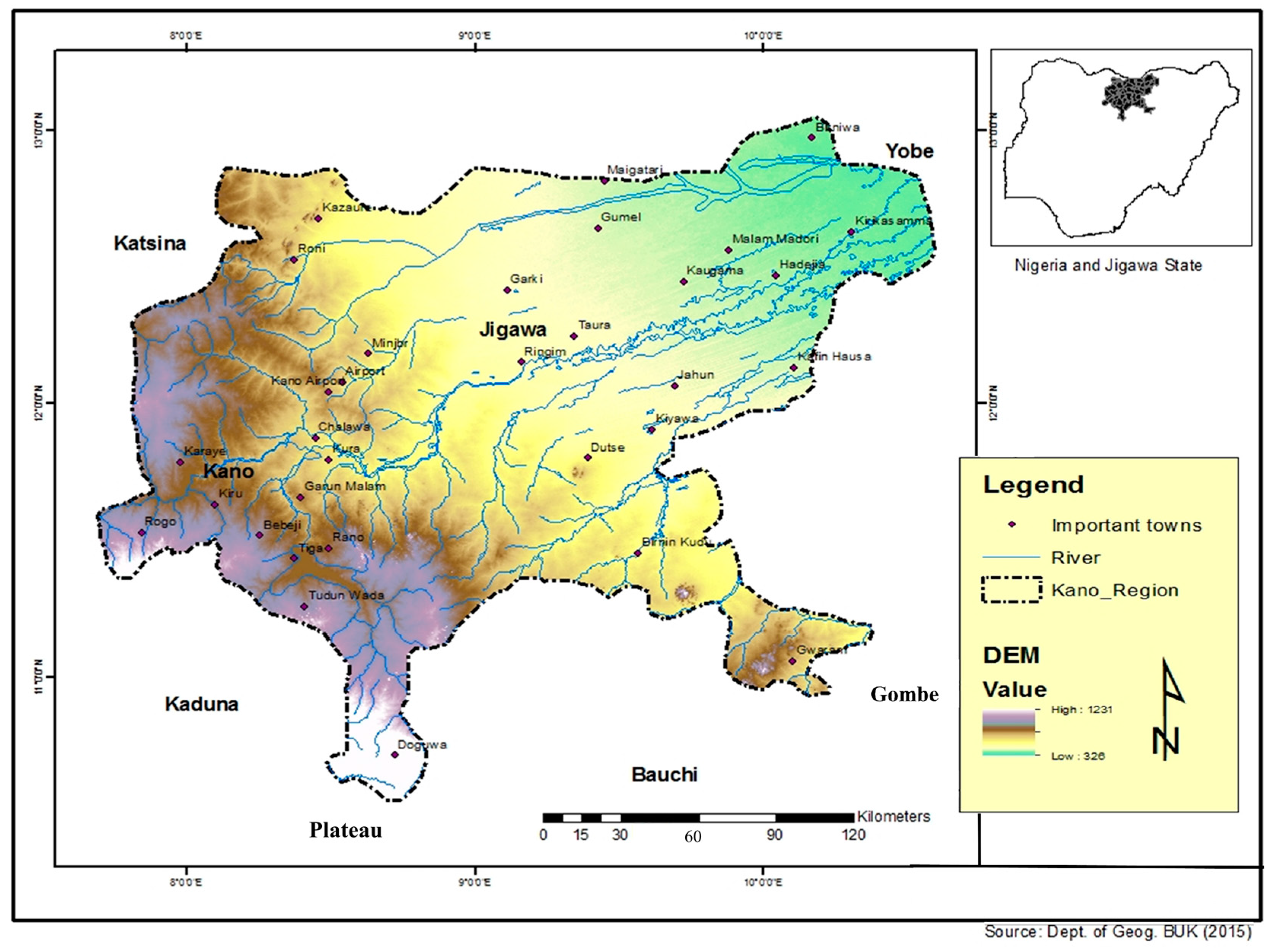
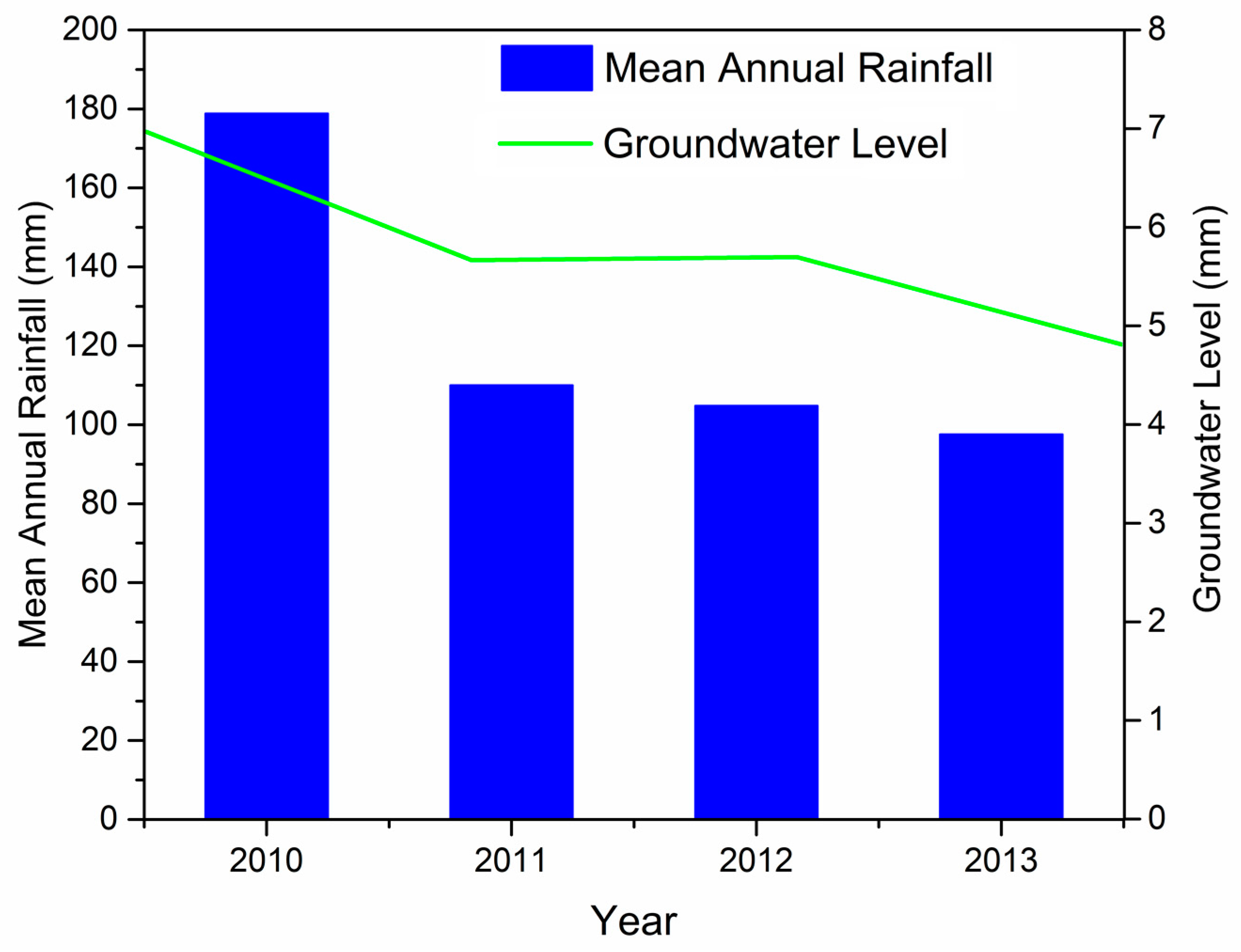
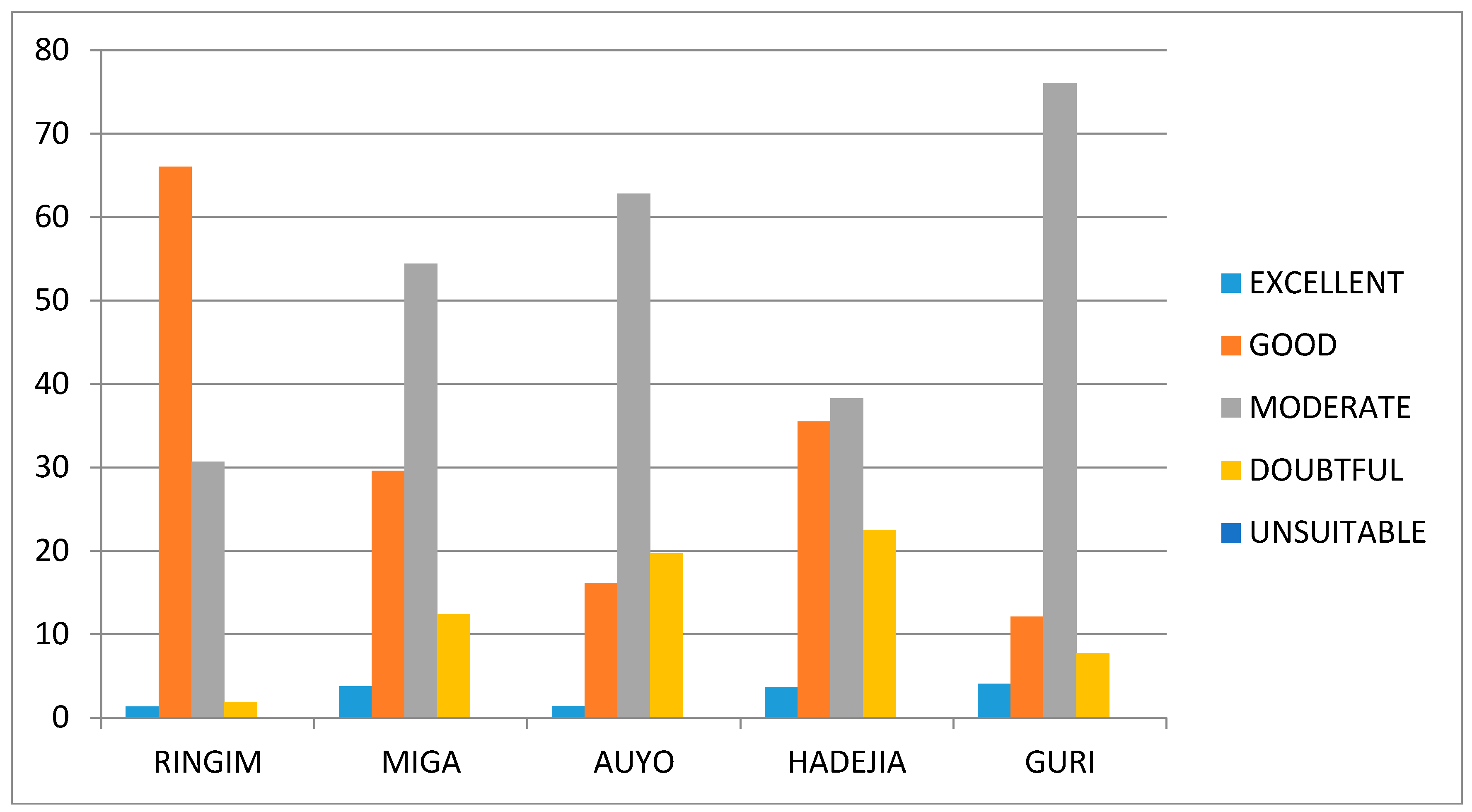
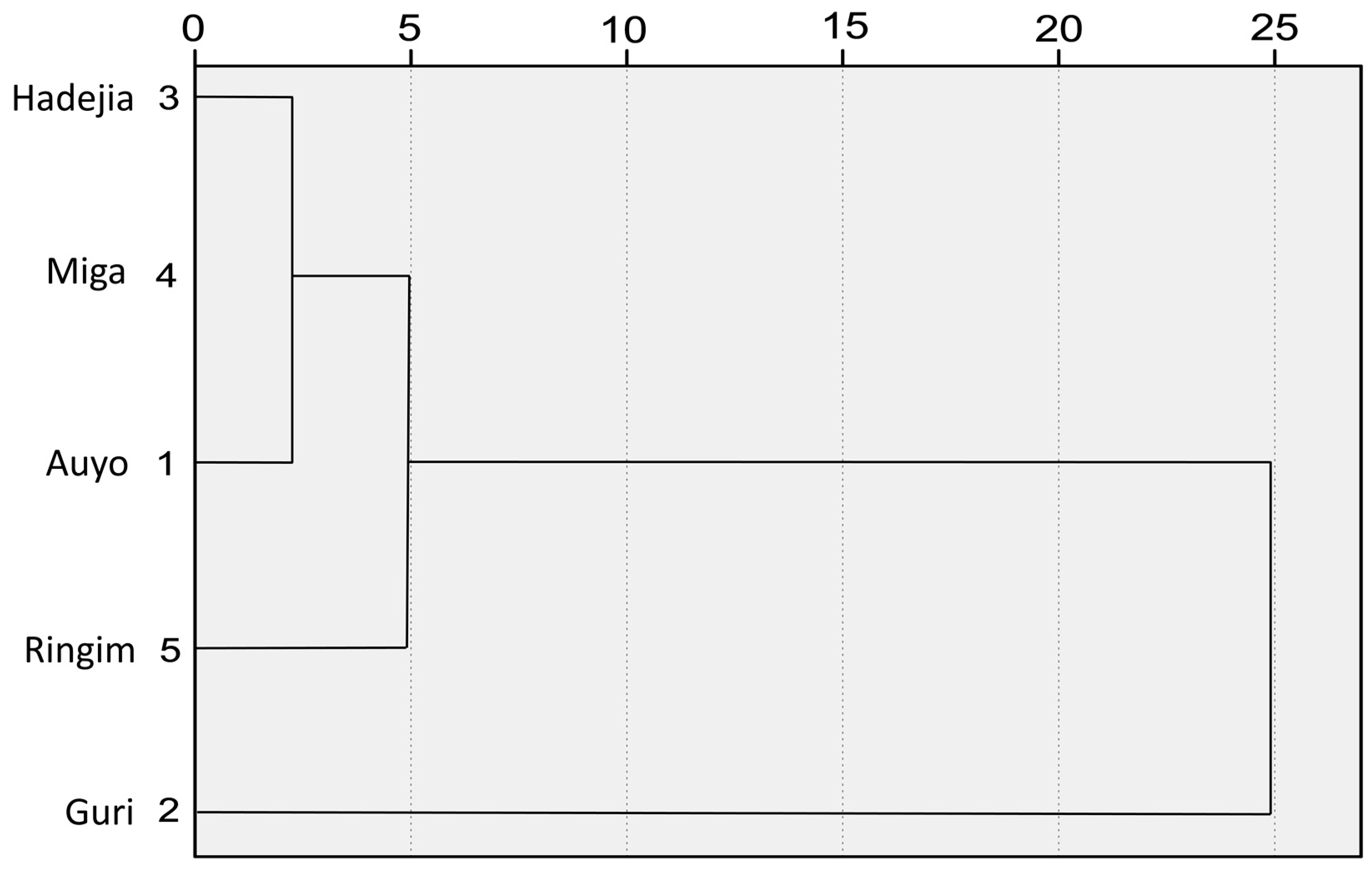
| Groundwater-Related Studies in Kano Region | |||||
|---|---|---|---|---|---|
| No. | Author (s) and Year | Research Objective and Location | Methodology | Research Findings | Comments |
| 1 | Tahir, et al. (2015) [17] | To assess the suitability of groundwater for irrigation & domestic use in the Kano metropolis, Nigeria. | A total of 20 groundwater samples were collected from deep and shallow boreholes. Piper &Wilcox diagramswere used, respectively, to determine hydrochemical facies& suitability of water for irrigation. | Piper diagram identified Ca-Mg_SO as the dominant water facie type. All the water samples fall within the C1-S1 hazard class based on a Wilcox plot. | No rigorous statistical tools used to support the result. |
| 2 | Abdulhamid, et al. (2014) [18] | To explore the missing link between the increasing rainfall and decreasing groundwater quantity in the Kano Basement Complex, Northwester Nigeria | 30-year rainfall data was obtained from global precipitation climatology center (GPCC) website, while groundwater data was obtained through field work. Percent change was used to analyze the data | The result shows that rainfall trend has been on the increase especially around the Metropolitan Kano from the late 1990s to date, with a corresponding decrease in groundwater quantity. | It is concluded that anthropogenic activities especially groundwater abstraction were identified as one of major causes. |
| 3 | Abdulhamid, (2014) [16] | To evaluate surface and groundwater resources in Kano Region, Northwestern Nigeria | Field work was undertaken to measure groundwater yield, aquifer thickness and volume covering 11 settlements. Data on rainfall were obtained from Kano State Water Board Office. | Migration of groundwater from basement complex to the sedimentary formation and rising demand of water by the ever increasing population, are among the major challenge facing water resources development in the area. | Three tier management strategy is proposed to address the existing water resource management in the region. |
| 4 | Tukur, (2017) [19] | To evaluate the suitability of groundwater for floodplain irrigation along Hadejia River Basin, Kano Region, Northwestern Nigeria | Data were collected through field work in both dry and rainy seasons covering a transect of about 15 km. A combination of multivariate chemometric, GIS and & classical hydrochemical methods was used to analyze the result | Groundwater dynamic level and yield decreases from the basement complex to the Chad formation region. IWQI model shows moderate > good > doubtful > excellent of the groundwater suitability | Groundwater suitability declines in the dry season than in the rainy season based on the four groundwater hazard classes |
| 5 | Mohammed, (2016) [20] | To assess the spatial variation of groundwater yield and vulnerability in the Kano Basement Complex, Northwestern Nigeria | Data on groundwater were obtained from Kano Water Board office, Kano State.GIS-based DRASTIC method was used to present the result. | 19% of the area has no yield. 42.5% of the underlain basement complex is fractured with 4% unproductive. The static water level was found between 4.16 and 27.6 m. | Nitrate validation indicated a strong relationship with DRASTIC model, suggesting low groundwater quality in the more polluted areas. |
| 6 | Garba, et al. (2016) [21] | To assess the hydrochemical processes controlling groundwater chemistry in Hadejia, Kano Region, Northwestern Nigeria. | Water samples was collected from 20 boreholes during rainy season. A combination of cluster analysis (CA), principal component analysis (PCA) and pearson product moment correlation was used to analyze the result | Anthropogenic activities, mineralization and weathering of geological deposits were identified as the key actors controlling groundwater chemistry by PCA | This suggests that the aquifer chemistry is mainly controlled by TDS, Mg, NO3−, Cu, Cl−, and Mn, which indicates the origin of major cations to be dissolution/precipitation processes. |
| 7 | Sobowale, et al. (2010) [22] | To assess water resources potentials of Hadejia River Sub-Catchments in Kano Region, Northwestern Nigeria | The available water in the sub-catchment was compared with existing and potential water demand | Results shows that about 2619 MCM of surface water is available annually upstream of Wudil (HS 1), 658 MCM is available between Wudil and Hadejia (HS 2), while 905 MCM is available between Hadejia and Gashua (HS 3). Analysis of direct ground water recharge revealed that 86mm, 94mm and 8mm of water is recharged to groundwater annually in the three hydrological sections HS 1, HS 2 and HS 3 respectively. | Projections show that the water use rate will reach 100% by 2018 |
| 8 | Adamu, et al. (2013) [23] | To assess the suitability of groundwater for drinking in the Basement Complex area of Kano, Nigeria. | Twenty sample of groundwater were collected from boreholes randomly located in five different geological settings (quartzite, granite, gneiss and schist) of the area. Simple descriptive statistics were used to present the result. | The quality of the sampled water were found to be within the WHO acceptable limit for drinking. Rock-water interaction & weathering play a vital role in the concentration of the investigated parameters. | No rigorous statistical tools used in analyzing the data. |
| 9 | Umar, (2016) [24] | To identify groundwater level fluctuation in Kano Sedimentary formation area, Northwester Nigeria | Groundwater level data of 4 years were obtained from the Hadejia River Basin Development Authority, Kano office. Simple descriptive statistics were used in analyzing the data. | There is steady decline of groundwater level from 2010 to 2013. | Over-abstraction of groundwater coupled with inadequate rainfall were identified as the key factors for that. |
| 10 | Tasi’u, et al. (2016) [25] | To assess water supply situation in rural Kano, Northwestern Nigeria | The study was achieved through in-depth interview with the inhabitants in the rural areas of Kano state. | 62.9% of the respondents indicated inadequacy of drinking water, with open well accounting for 41.4% of the sources of water in the area. | The study recommends provision of bore holes to address the inadequacy of drinking water |
| Groundwater-Related Studies outside Kano Region | |||||
| 11 | Rizwan, et al. (2017) [26] | To assess the effect of rainfall factor on groundwater recharge in Banghar Environs, India | Statistical analysis such as mean, median, mode and the co-efficient standard deviation, co-efficient of dispersion, co-efficient of variation and co-efficient of skewness were used to analyze the data. | The years revealing more than the average annual rainfall values indicate positive recharge of groundwater trend and vice versa. Cumulative departure exhibit positive and negative trends and the determination of moving rainfall average provide a picture of cycle variation of rainfall trend. | It is suggests that implementation of a rainfall augmentation scheme would provide appropriate rainfall recharge to the groundwater system and it would also resolve the water crises problem |
| 12 | Mastrocicco, et al. (2011) [27] | To introduce good agricultural practices that reduce the amount of nitrate entering the groundwater system | The study was achieved through quantification of kinetic control on nitrate attenuation capacity. The geochemical code PHREEQC (version 2) was used to simulate kinetic denitrification using Monod equation, equilibrium, langmuir sorption of acetate, and equilibrium reactionsof gas and mineral phases (calcite). | The reactive modeling results showed a rapid acetate andnitrate mineralization rate, implying that the main pathway of nitrate attenuation is through denitrification while calcite acted as a buffer for pH. | Reactive modeling is thought to be an efficient and robust tool to quantify the complex biogeochemicalreactions which can take place in undergroundenvironments |
| 13 | Colombani, et al. (2016) [28] | To quantify the present and potential (2050) salinization of a coastal aquifer in the Po Delta, Italy | A combination of SEAWAT 4.0 and PESTwas used for the prediction and automatic inverse parameter calibration, respectively. | Results show that the Po Delta will experience a significant salinization by 2050 and that the major cause is autonomous salinization via seepage of saline groundwater rather than enhanced seawater intrusion due to sea level rise. | This scenario allowed us to identify the zones that are more affected by the relative sea level rise and to quantify the increase in salinization of groundwater. |
| 14 | Macdonald, et al. (2012) [29] | To present the first quantitative maps of aquifer storage and potential borehole yields in Africa | The study made extensive review of available maps, publications and data on groundwater availability and yield in Africa. | Groundwater storage was estimated to be 0.66 million km3 (0.36–1.75 million km3). The largest groundwater volumes are found in the large sedimentary aquifers in the North African countries Libya, Algeria, Egypt and Sudan. | Drilling of high yielding boreholes are likely to be unsuccessful in rapidly urbanizing cities, because the potential for higher yielding boreholes (>5 L S−1) is much more limited |
| 15 | Taylor, et al. (2009) [30] | To review strategic research issues pertaining to relationship between groundwater and climate in Africa, with a view to improving current understanding of the impact of climate on groundwater resources in Africa | The study was achieved through review of 96 papers presented in the Groundwater and Climate in Africa Conference. | Groundwater is well placed toenable communities to adapt to changes in freshwater demand and availability in many parts ofAfrica, but substantial uncertainty remains around the development and management of groundwater-based solutions. | Future research on water resources and climate change needs to focus on shorter time scales and consider uncertainty explicitly, providingquantitative probability measures properly conditioned on measured values of the variables |
| 16. | Tukur, et al. (2016) [9] | To evaluate methodological approaches and trend in groundwater quality studies across developing countries | Bibliographic survey of groundwater quality studies covering 13 years (2003–2016) across developing countries was used to review both review and article papers. | Statistical approach (29%), hydro geochemical (24%) and GIS (25%) methods are the dominant techniques used and are being more utilized in the Asian countries. There is generally poor knowledge regarding groundwater condition from floodplain aquifers of Nigeria since the commencement of shallow boreholes programme in 1986 | The use of Artificial Neural Network (ANN), Structural Equation Modeling (SEM), Decision Tree Models (DTM) and numerical modeling such as MUDFLOW were found to be lacking especially in African countries. |
| 17 | Adewuyi and Olofin (2014) [31] | To characterize the pattern of flood incidences in the year 2012 across Nigeria with the aim of establishing the implications on land degradation | Data on flood incidences were obtained from the Nigerian Metrological Station.Simple descriptive statistics was used in analyzing the data. | The results revealed 52 major flood incidences within 88 days: The spatial distributions are: North Central geopolitical zone recorded 31%, South South 21%, North West 17%, North East 15%, South East 12% and South West 4% respectively | The floods affected mostly states adjacent to the major rivers and in manyinstances aggravated land degradation |
| 18 | Bakhari, (2014) [32] | To assess the hydrogeochemical process and anthropogenic factors controlling groundwaterquality of the upper unconfined aquifer system of the Chad Basin, Maiduguri, Nigeria. | Twenty samples of groundwater were collected from shallow tube wells located in 2 different sites. ANOVA was used to show the variation of the parameters between the 2 sites | 75%& 25% of The water samples were found to be Ca-HCO3 & Na-HCO3 water type. Ion-exchange, silicate weathering and calcium carbonate dissolution across the basin are responsible for the concentration of the major ions. Concentration of nitrate, chloride, sulphate & phosphate were attributed to agricultural and industrial activities | The study could have used multivariate statistical techniques such as PCA, HACA and the likes to explain the result. |
| 19 | Fagbote, et al. (2013) [33] | To develop groundwater quality index for drinking in Agbabu and Temidire bitumen deposit area of Ondo state, Nigeria. | Groundwater samples from six boreholes and hand dug wells were collected in dry and rainy season of years 2008 and 2009. Entropy weighted methods was used in determining the water quality index. | WQI ranked all the groundwater samples from wells as excellent and good in dry and rainy seasons, respectively. | The small number of samples did not allow for geospatial mapping of WQI in the study area. |
| 20 | Obiefuna & Sheriff (2011) [34] | To assess the shallow groundwater quality for irrigation & domestic purpose of Pindiga area, Gombe State, Northeastern Nigeria | A total of 15 groundwater samples were collected from hand dug wells taping shallow aquifer during rainy season. Irrigation water quality indices (EC, TDS, SAR, MAR, PI, KR, SSP & RSBC) were computed to assess water suitability for irrigation. | All water quality indices for irrigation of thesampled water fall within the permissible level indicating low sodic waters. | The study could have used geospatial tool to map the distribution of groundwater quality indices in the study area. |
| 21 | Obiefuna & Orazulike (2011) [35] | To map groundwater facie of Yola area, Northeastern Nigeria | A total of 27 groundwater samples were collected. | Chloride-sulphate & bicarbonate were found to be the dominant water facie, indicating dissolution and/or weathering of minerals along the flow paths | Geospatialt & geochemical techniques would have been better in presenting the result. |
| 22 | Adelana, (2006) [36] | To determine the distribution, sources & implications of nitrate concentration from the groundwater of Nigerian aquifers. | Groundwater samples covering 2, 200 & 350 wells from 1985 to 2004 and pre-1970, respectively, were collected through staff-students research project and from the Geological Survey of Nigeria. | High concentration of NO3 (>1000 mg/L) occurred more in the sedimentary basins in areas with intense agricultural & fertilizer application than in the basement complex aquifers (<5 mg/L). | No rigorous analysis of data to support the finding of the study. |
| 23 | Boukari and Alassane, (2006) [37] | To minimize the quality & quantity deterioration of aquifer water resources in Benin City, Nigeria | DRASTIC model with graphical methods were used respectively in presenting groundwater vulnerability & quality status | Piper diagram identified the water as Na-Cl water type with concentration within the acceptable limit. Result from DRASTIC model indicate moderate vulnerable to vulnerable | No rigorous statistics to support & validate the result of DRASTIC model |
| 24 | Graham, et al. (2006) [38] | To assess the suitability of groundwater for irrigation in the southwestern Sokoto Rima Basin, Nigeria. | A total of 40 groundwater samples were collected from open wells, tube wells & boreholes in 4 different locations. Simple descriptive statistics were used to explain the result. | The quality of water appeared to have no salinity & sodicity hazard. | No rigorous statistical tools used in analyzing the data. |
| 25 | Nakoma, et al. (2016) [4] | To evaluate the suitability of groundwater for domestic use in Mzimba, northern Malawi. | Groundwater samples were collected in triplicate from 20 randomly selected boreholes located in five villages. PCA, one-way ANOVA & LSD statistical methods were used respectively to detect correlation among the parameters, establish differences & make multiple comparisons between the variables. | The level of water pollution in all the locations is generally no significant | Recommended for spatio-temporal assessment and microbiological analysis of groundwater. |
| 26 | Mehra, et al. (2016) [39] | To assess groundwater quality, potentials & vulnerability for agricultural use in the Mewat district of Haryana, India | Groundwater quality, potentials & vulnerability were determined using weighted index, weighted overlay & DRASTIC method, respectively. Multivariate clustering was used to integrate the result of groundwater quality, potentials & vulnerability. | The study generated map with 5 zones based on groundwater quality, potentials & vulnerability, with zone 1 being the best area for agriculture characterized with god quality water, moderate water potential & lesser vulnerability to contaminants | The study provides asound basis for the planning of sustainable groundwaterresources management for agriculture |
| 27 | Kumar, et al. (2007) [3] | To identify seasonal variation of groundwater suitability for irrigation & drinking purpose between two irrigated regions of Punjab, India | 15 groundwater samples were collected from each district in both dry and wet season. Sampled wells were selected based on difference in geology, landuse and aquifer depth in each region. Interview with 10 villagers from each district was carried out to measure their perception on test & color of groundwater | Groundwater is suitable for irrigation & drinking in most of the locations with excessive leaching, dilution & flushing of minerals in the Muktsar & Patiala village, respectively | No rigorous statistics & GIS analysis used |
| 28 | Gereish, et al. (2015) [40] | To assess implications of climate change on groundwater flow regime & geochemistry of the Pleistocene aquifer, Nile Delta, Egypt | Hydrogeological field survey was carried out for measuring water depth & collection of 78 samples of groundwater from wells for hydrochemical analysis. Stable isotope method was used to map the groundwater flow direction & major hydrochemical facie of the groundwater samples. | Groundwater chemical composition was attributed not to sea level rise & seawater intrusion, but rather the geochemical process including a combination of salt dissolution, ion exchange & evaporation. The salinity distribution of the two aquifers is highly conformable with the groundwater flow map. The groundwater facie was identified as Ca-HCO3, NaHCO3-Na-mix fresh water type | The naturally imported Nile water is thought as the main source of recharge for the whole groundwater in the Nile Delta & surrounding desert. |
| 29 | Sappa, et al. (2015) [41] | To identify the factors influencing and assess seasonal changes of groundwater composition in the coastal aquifers of Tanzania. | Pattern diagrams, geochemical modeling techniques and PCA were used to identify the main factors affecting groundwater composition from 72 wells of the study area. | The groundwater falls into the category C2-S1,C3-S1, C3-S2, C4-S2. PCA revealed seawater intrusion, evaporation& NO3 as the major factors influencing the groundwater chemistry | SEM as an advancement of PCA can be used to support the result of the study. |
| 30 | Sharma & Chhipa, (2013) [42] | To provide water quality index for Jaipur city of India | Groundwater samples were collected from 12 villages of the study area in dry season. CC, WQI & WHO were used to analyze & compare the obtained result with the standards, respectively | Result of WQI classifies the water under poor quality (123.76) for drinking purpose. CC revealed high correlation between EC & TDS (0.996), indicating high salinity level in the water | Recommended to carry out a similar study in the rainy season with a view of finding variation in the water quality. |
| 31 | Barbiero, et al. (2002) [43] | To investigate the level of variability and associated process of salinity in the wetland of the nhecolandia, pantanal of mato grosso, Brazil | A total number of 41 samples were taken from groundwater between 1994 and 1999. PCA, CC & Piper diagram were used to explain the result. | PCA identified evaporation as the principal process controlling groundwater chemistry. Piper diagram classified the water as Na+/HCO3 water type. | Recommended to focus on water & solute flows in the wetland of the area. |
| Hazard Groups | Parameters | Unit | Maximum Permissible Limit (FAO, 1998) | Weight; wi | Relative Weight; |
|---|---|---|---|---|---|
| Salinity Hazard | EC | μS cm−1 | 3000 | 5 | 0.1316 |
| Permeability/Infiltration Hazard | SAR | meq L−1 | 26 | 4 | 0.1053 |
| %Na | meq L−1 | 80 | 4 | 0.1053 | |
| KR | meq L−1 | 1 | 4 | 0.1053 | |
| MH | meq L−1 | 50 | 4 | 0.1053 | |
| PI | meq L−1 | 25% | 4 | 0.1053 | |
| Specific Ions Toxicity Hazard | B | mg L−1 | 3.0 | 3 | 0.0789 |
| Cl− | mg L−1 | 350 | 3 | 0.0789 | |
| RSC | meq L−1 | 2.5 | 3 | 0.0789 | |
| Miscellaneous Hazard | pH | - | 8.5 | 2 | 0.0526 |
| HCO3− | mg L−1 | 500 | 2 | 0.0526 | |
| ∑wi = 38 | ∑Wi = 1.0000 |
| Time | Diurnal Variation of Groundwater Yield (L/s) | Total Average | % | |||||||||
|---|---|---|---|---|---|---|---|---|---|---|---|---|
| Ringim | Miga | Auyo | Hadejia | Guri | ||||||||
| Range | Average | Range | Average | Range | Average | Range | Average | Range | Average | |||
| Morning | 2.0–3.3 | 2.58 | 0.5–3.5 | 2.4 | 1.3–3.4 | 2.6 | 1.9–3.4 | 2.6 | 1.8–3.2 | 2.5 | 12.68 | 44 |
| Evening | 3.0–5.3 | 3.78 | 0.5–4.5 | 3.0 | 1.6–4.0 | 3.2 | 2.3–4.0 | 3.3 | 2.5–3.7 | 2.9 | 16.18 | 56 |
| Total | 2.0–5.3 | 6.36 | 0.5–4.5 | 5.4 | 1.3–4.0 | 5.8 | 1.9–4.0 | 5.9 | 1.8–3.7 | 5.4 | 28.86 | 100 |
© 2018 by the authors. Licensee MDPI, Basel, Switzerland. This article is an open access article distributed under the terms and conditions of the Creative Commons Attribution (CC BY) license (http://creativecommons.org/licenses/by/4.0/).
Share and Cite
Tukur, A.I.; Nabegu, A.B.; Abba Umar, D.; Olofin, E.A.; Sulaiman, W.N.A. Groundwater Condition and Management in Kano Region, Northwestern Nigeria. Hydrology 2018, 5, 16. https://doi.org/10.3390/hydrology5010016
Tukur AI, Nabegu AB, Abba Umar D, Olofin EA, Sulaiman WNA. Groundwater Condition and Management in Kano Region, Northwestern Nigeria. Hydrology. 2018; 5(1):16. https://doi.org/10.3390/hydrology5010016
Chicago/Turabian StyleTukur, Abubakar Ibrahim, Aliyu Baba Nabegu, Da’u Abba Umar, Emmanuel Ajayi Olofin, and Wan Nor Azmin Sulaiman. 2018. "Groundwater Condition and Management in Kano Region, Northwestern Nigeria" Hydrology 5, no. 1: 16. https://doi.org/10.3390/hydrology5010016





